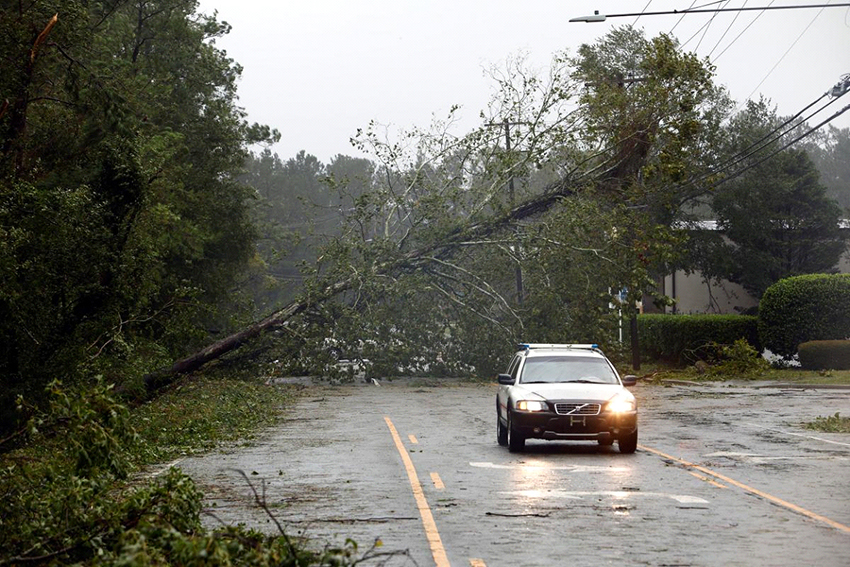WILMINGTON, N.C., (Reuters) – Florence crashed into the Carolina coast yesterday, felling trees, dumping nearly three feet of rain on some spots and leading to the death of four people before it was downgraded to a tropical storm still capable of wreaking havoc.
The storm’s first casualties included a mother and her baby, who died when a tree fell on their brick house in Wilmington, North Carolina. The child’s father was injured and taken to a hospital.
In Pender County, North Carolina, a woman suffered a fatal heart attack; paramedics trying to reach her were blocked by debris. A fourth victim was killed in Lenoir County while plugging in a generator, according to the governor’s office.
“To those in the storm’s path, if you can hear me, please stay sheltered in place,” North Carolina Governor Roy Cooper said at a news conference in Raleigh, adding that Florence would “continue its violent grind across the state for days.”
Florence had been a Category 3 hurricane with 120-mph winds on Thursday, but dropped to Category 1 before coming ashore.
After landfall, Florence slowed to a pace that would see the system likely lingering for days. The National Hurricane Center downgraded it to a tropical storm but said life-threatening storm surges and catastrophic freshwater flooding were expected over portions of North and South Carolina.
The storm surge, water pushed by a storm over land that would normally be dry, “overwhelmed” the town of New Bern at the confluence of the Neuse and Trent rivers, Cooper said.
Parts of North and South Carolina were forecast to get as much as 40 inches of rain (1 meter).
More than 60 people, including many children, were evacuated from a hotel in Jacksonville, North Carolina, after strong winds caused parts of the roof to collapse. Many of the evacuees had pets with them.
Maysie Baumgardner, 7, sheltered with her family at the Hotel Ballast in downtown Wilmington as Florence’s floodwaters filled the streets. “I’m a little bit scared right now,” she said, “but I have my iPad and I’m watching Netflix.”
Cooper said Florence was expected to cover almost all of North Carolina in several feet of water.
As of Friday morning, Atlantic Beach, a town on the state’s Outer Banks barrier islands, had received 30 inches (76 cm) of rain, the U.S. Geological Service said.
Twenty inches were reported by early Friday afternoon in the town of Oriental.
The center of the hurricane’s eye came ashore at about 7:15 a.m. EDT (1115 GMT) near Wrightsville Beach close to Wilmington, with sustained winds of 90 miles per hour (150 kph), the National Hurricane Center (NHC) said.
By late afternoon, the center of the storm was about 25 miles northeast of Myrtle Beach, South Carolina, with maximum sustained winds of 70 mph.
Authorities in New Bern, a town of about 30,000 people that dates to the early 18th century, said more than 100 people had to be rescued from floods. The downtown area was underwater.
Calls for help multiplied as the wind picked up and tide rolled in, city public information officer Colleen Roberts said.
“These are folks who decided to stay and ride out the storm for whatever reason, despite having a mandatory evacuation,” she said. “These are folks who are maybe in one-story buildings and they’re seeing the floodwaters rise.”
TRUMP PLANS VISIT
Video taken in several towns in the Carolinas showed emergency personnel wading through thigh-high water.
The White House said on Friday President Donald Trump would travel to the region next week unless his visit would disrupt cleanup and rescue efforts.
Governor Cooper said the state would arrange a visit by Trump “at an appropriate time.”
A tree crashed into Kevin DiLoreto’s home in Wilmington, where all roads leading to his neighborhood were blocked by fallen trees. “It’s insane,” he said by telephone. “I’ve never seen tree devastation this bad.
“Afterwards, I’m going to drink a bottle of whiskey and take a two-day nap, but right now I’m walking the neighbourhood making sure my neighbors are fine because nobody can get in here.”
More than 722,000 homes and businesses were without power in the Carolinas early on Friday, utility officials said. Utility companies said millions were expected to lose power and restoration could take weeks.
The storm was expected to move across parts of southeastern North Carolina and eastern South Carolina on Friday and Saturday, then head north over the western Carolinas and central Appalachian Mountains early next week, the NHC said. Significant weakening was expected over the weekend.
About 10 million people could be affected by the storm.
Florence was one of two major storms threatening millions of people on opposite sides of the world. Super Typhoon Mangkhut was expected to hit an area in the Philippines on Saturday that would affect 5.2 million people.

